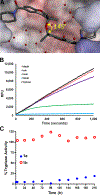A Novel, Nonpeptidic, Orally Active Bivalent Inhibitor of Human β-Tryptase
- PMID: 30134249
- PMCID: PMC6242772
- DOI: 10.1159/000492078
A Novel, Nonpeptidic, Orally Active Bivalent Inhibitor of Human β-Tryptase
Abstract
β-Tryptase is released from mast cells upon degranulation in response to allergic and inflammatory stimuli. Human tryptase is a homotetrameric serine protease with 4 identical active sites directed toward a central pore. These active sites present an optimized scenario for the rational design of bivalent inhibitors, which bridge 2 adjacent active sites. Using (3-[1-acylpiperidin-4-yl]phenyl)methanamine as the pharmacophoric core and a disiloxane linker to span 2 active sites we have successfully produced a novel bivalent tryptase inhibitor, compound 1a, with a comparable profile to previously described inhibitors. Pharmacological properties of compound 1a were studied in a range of in vitro enzymic and cellular screening assays, and in vivo xenograft models. This non-peptide inhibitor of tryptase demonstrated superior activity (IC50 at 100 pmol/L tryptase = 1.82 nmol/L) compared to monomeric modes of inhibition. X-ray crystallography validated the dimeric mechanism of inhibition, and 1a demonstrated good oral bioavailability and efficacy in HMC-1 xenograft models. Furthermore, compound 1a demonstrated extremely slow off rates and high selectivity against-related proteases. This highly potent, orally bioavailable and selective inhibitor of human tryptase will be an invaluable tool in future studies to explore the therapeutic potential of attenuating the activity of this elusive target.
Keywords: Bivalent inhibitor; Disiloxane; Protease inhibitors; Tight-binding; X-ray analysis; β-Tryptase.
© 2018 S. Karger AG, Basel.
Conflict of interest statement
Conflicts of Interest
SFG, LDA, MP, DEB, and FB. are Blinkbio Inc. shareholders. DSW and MP are employed by Blinkbio Inc.
Figures




References
-
- Bradding P, Feather IH, Wilson S, Bardin PG, Heusser CH, Holgate ST, Howarth PH: Immunolocalization of cytokines in the nasal-mucosa of normal and perennial rhinitic subjects - the mast-cell as a source of IL-4, IL-5, and IL-6 in human allergic mucosal inflammation. J Immunol 1993;151:3853–3865. - PubMed
-
- Reed CE, Kita H: The role of protease activation of inflammation in allergic respiratory diseases. J Allergy Clin Immunol 2004;114:997–1008. - PubMed
-
- Schwartz LB: Mast-cells - function and contents. Curr Opin Immunol 1994;6:91–97. - PubMed
-
- Munitz A, Piliponsky AM, Levi-Schaffer F: IgE-Independent Activation of Human Mast Cells Indicates their Role in the Late Phase Reaction of Allergic Inflammation. Cell Tissue Bank 2003;4:25–28. - PubMed
MeSH terms
Substances
Grants and funding
LinkOut - more resources
Full Text Sources
Other Literature Sources

